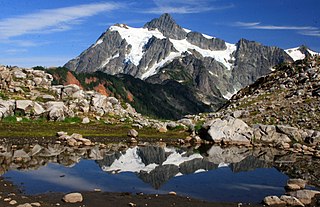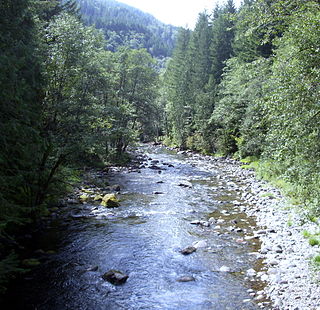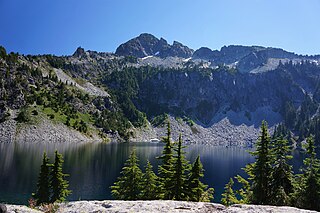
The Snoqualmie River is a 45-mile (72 km) long river in King County and Snohomish County in the U.S. state of Washington. The river's three main tributaries are the North, Middle, and South Forks, which drain the west side of the Cascade Mountains near the town of North Bend and join near the town of Snoqualmie just above the Snoqualmie Falls. After the falls the river flows north through rich farmland and the towns of Fall City, Carnation, and Duvall before meeting the Skykomish River to form the Snohomish River near Monroe. The Snohomish River empties into Puget Sound at Everett. Other tributaries of the Snoqualmie River include the Taylor River and the Pratt River, both of which enter the Middle Fork, the Tolt River, which joins at Carnation, and the Raging River at Fall City.

The North Cascades are a section of the Cascade Range of western North America. They span the border between the Canadian province of British Columbia and the U.S. state of Washington and are officially named in the U.S. and Canada as the Cascade Mountains. The portion in Canada is known to Americans as the Canadian Cascades, a designation that also includes the mountains above the east bank of the Fraser Canyon as far north as the town of Lytton, at the confluence of the Thompson and Fraser Rivers.

The Salmon River is a 33.5-mile (53.9 km) river in the Cascade Range in the U.S. state of Oregon that drains part of southwestern Mount Hood. The entire length of the river is a protected National Wild and Scenic River. Several portions are in protected wilderness. It is affluent to the Sandy River, a tributary of the Columbia River.
The valley of the West Fork Foss River contains a fair amount of waterfalls. The river heads in a series of large lakes: Big Heart Lake, Angeline Lake, and Otter Lake- which form spectacular waterfalls as they plunge down to Delta Lake. On the valley walls downstream of Delta Lake, are found even more waterfalls.

The Foss River is a stream in the U.S. state of Washington. It has two main forks, the East Fork Foss River and the West Fork Foss River. The main stem is formed by the confluence of the two forks. The river and its forks rise near in the Alpine Lakes Wilderness area of Mount Baker-Snoqualmie National Forest in the Cascade Mountains and flows generally north, joining the Tye River to form the South Fork Skykomish River. The Foss River's waters eventually empty into Puget Sound near Everett via the Skykomish River and Snohomish River.

Angeline Lake is a freshwater lake located on the northern slope of Iron Cap Mountain between Otter Lake, Azure Lake and Big Heart Lake, in King County, Washington. Self-issued Alpine Lake Wilderness permit required for transit within the Big Snow Mountain area. West Fork Foss River exits Angeline Lake into a canyon that produces Angeline Falls downstream from Chetwoot Lake to Delta Lake. Because Angeline Lake is at the heart of the Alpine Lakes Wilderness, the lake is a popular area for hiking, swimming, and fishing golden trout, rainbow trout, and cutthroat trout.

Chetwoot Lake is a freshwater lake located on the western slope of Iron Cap Mountain next to Crawford Lake, in King County, Washington. West Fork Foss River exits Chetwoot Lake towards Angeline Lake and then to a canyon that produces Angeline Falls downstream towards Delta Lake. Because Chetwoot Lake is at the heart of the Alpine Lakes Wilderness, the lake is a popular area for hiking, swimming, and fishing.

Opal Lake, also known as Necklace Valley Lake 3, is a freshwater lake located on the western region of the Alpine Lakes Wilderness, in King County, Washington. The lake is connected by stream to Emerald Lake and Jade Lake, which form together the Neckelace Valley Lakes. Opal Lake and its surrounding lakes and peaks are a popular area for hiking, swimming, and fishing Rainbow trout. Self-issued Alpine Lake Wilderness permit required for transit within the Necklace Valley area.

Jade Lake, also known as Necklace Valley First Lake, is a freshwater lake located on the western region of the Alpine Lakes Wilderness, in King County, Washington. It is the first of three lakes that are connected by stream which together form the Neckelace Valley Lakes. Jade Lake and its surrounding lakes and peaks are a popular area for hiking, swimming, and fishing cutthroat trout. Self-issued Alpine Lake Wilderness permit required for transit within the Necklace Valley area.

Emerald Lake is a freshwater lake located on the western region of the Alpine Lakes Wilderness, in King County, Washington. It is one of three lakes that are connected by stream which together form the Neckelace Valley Lakes. Emerald Lake and its surrounding lakes and peaks are a popular area for hiking, swimming, and fishing cutthroat trout and rainbow trout. Self-issued Alpine Lake Wilderness permit required for transit within the Necklace Valley area.

Lake Iiswoot is a freshwater lake located on the western region of the Alpine Lakes Wilderness, in King County, Washington. It is located on the eastern slope of Necklace Valley. Lake Iiswoot and its surrounding lakes and peaks is a popular area for hiking, swimming, and fishing. Self-issued Alpine Lake Wilderness permit required for transit within the Necklace Valley area.

Otter Lake is a freshwater lake located on the western slope of Otter Point northwest of Maple Valley in King County, Washington. Self-issued Alpine Lake Wilderness permit required for transit within the Big Snow Mountain area. Other prominent lakes are west of Otter Lake, including Angeline Lake, Azurite Lake and Big Heart Lake, while Opal Lake and other Necklace Valley lakes are on the eastern slope of Otter Point. Because Otter Lake is at the heart of the Alpine Lakes Wilderness, the lake is a popular area for hiking, swimming, and fishing.

Azurite Lake is a freshwater lake located in the Alpine Lakes Wilderness, between Otter Lake and Angeline Lake in King County, Washington. A short distance south towards Iron Cap Mountain is Azure Lake and Iron Cap Lake. The south shore of the lake rests on a prominent granite ledge up towards a hillock and steep heathland that lead to Iron Cap Mountain. The North shore of the lake is bound by the steep slopes of Saint Agnes Ridge which continue on the eastern slopes of Angeline Lake. Self-issued Alpine Lake Wilderness permit required for transit within the Necklace Valley area.

Azure Lake is a small freshwater lake located in the Alpine Lakes Wilderness, between Azurite Lake and Angeline Lake in King County, Washington. A short distance south towards Iron Cap Mountain is Iron Cap Lake. Towards the North are the steep slopes of Saint Agnes Ridge which continue eastwards towards Otter Lake. Self-issued Alpine Lake Wilderness permit required for transit within the Necklace Valley area. Azure Lake is located in a prominent valley along the southern skirt of the Mount Daniel area in connection with the North-Middle Forks Snoqualmie mountain grouping area.

Iron Cap Lake is a small freshwater lake located in the Alpine Lakes Wilderness, at the south ridge of Azurite Lake and other Necklace Valley lakes in King County, Washington. The lake is nestled on the north skirt of Iron Cap Mountain and produces the West Fork of the Foss River towards Bonnie Lake and contributions from Otter Lake. A short distance towards the West are Crawford Lake and Chetwoot Lake. Self-issued Alpine Lake Wilderness permit required for transit within the Necklace Valley area.

Crawford Lake is a freshwater lake located in the Alpine Lakes Wilderness, at the western ridge of Iron Cap Mountain in King County, Washington. The lake is nestled on a set of prominent valleys and peaks and produces Crawford Creek which flows as one of many tributaries of the Middle Fork Foss River. A short distance towards the north are Chetwoot Lake, Angeline Lake and the Necklace Valley Lakes. Self-issued Alpine Lake Wilderness permit required for transit within the Necklace Valley area.

Delta Lake is a freshwater lake located in the Alpine Lakes Wilderness, north of the Necklace Valley lakes in King County, Washington. Because Delta lake is at the heart of the Alpine Lakes Wilderness, the lake is a popular area for hiking, swimming, and fishing rainbow trout, and cutthroat trout. Delta Lake is a consequence of the spill of the outlets of three major Alpine Lakes: Otter Lake, Big Heart Lake, and Angeline Lake. The West Fork of the Foss River exits Delta Lake in two outlets which merge into one stream shortly above the top of Upper Foss River Falls.

Bald Eagle Lake is a freshwater lake located on the north skirt of Screeching Eagle Peak, a U-shaped ridge massif formed by the junction of Bald Eagle Peak and Silver Eagle Peak, between the West Fork and East Fork of Foss River, in King County, Washington. Other prominent lakes are south of Bald Eagle Lake, including Locket Lake, Otter Lake and Lake Iiswoot, Opal Lake and other Necklace Valley lakes on the eastern slope of Otter Point. Mount Hinman and Mount Daniel are a short distance southeast. Because Bald Eagle Lake is at the heart of the Alpine Lakes Wilderness, the lake is a popular area for hiking, swimming, and fishing.

Myrtle Lake is a freshwater lake located on the northern slope of Big Snow Mountain between Snoqualmie Lake and Chetwoot Lake, in King County, Washington. Self-issued Alpine Lake Wilderness permit required for transit within the Big Snow Mountain area. Because Myrtle Lake is at the heart of the Alpine Lakes Wilderness, the lake is a popular area for hiking, swimming, and fishing rainbow trout and coastal cutthroat trout.

Gold Lake is a freshwater lake located on a valley on the west skirt of Wild Goat Peak, in King County, Washington. Gold Lake is surrounded by prominent peaks and lakes at the heart of the Alpine Lakes Wilderness, including Big Snow Mountain and Iron Cap Mountain.







